
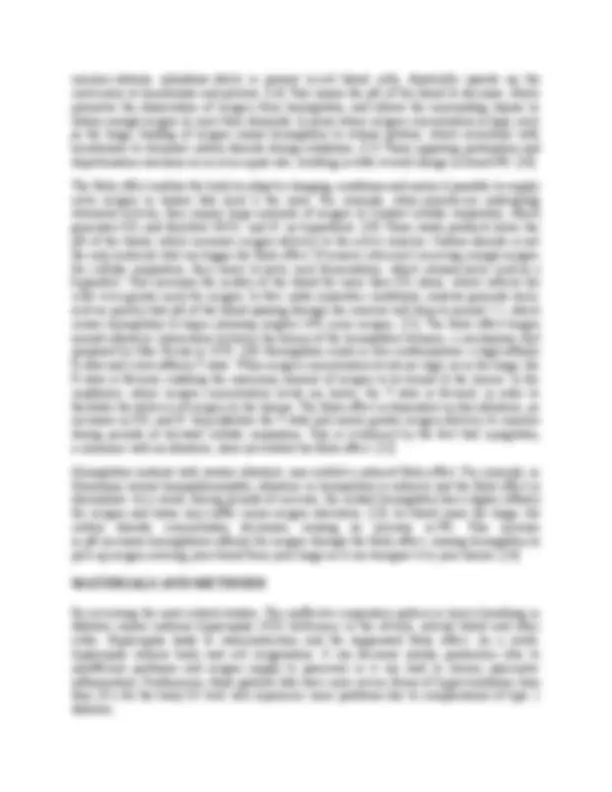
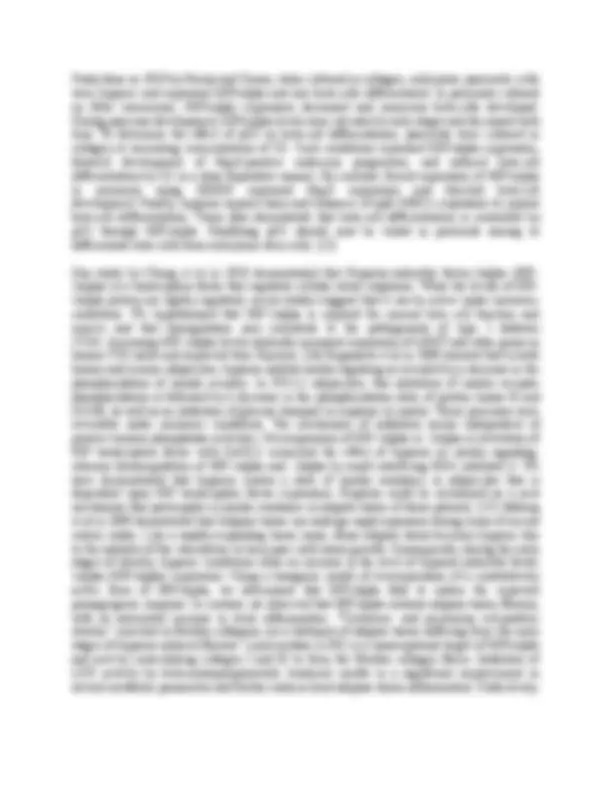

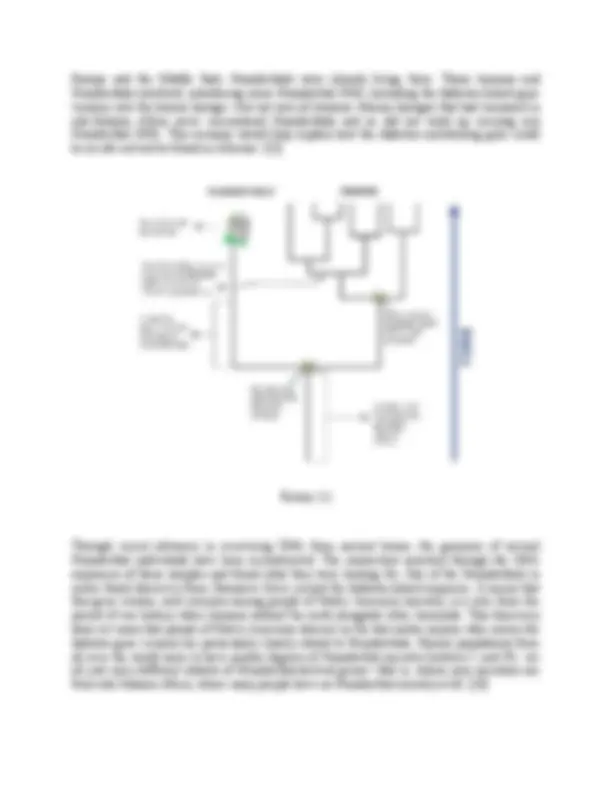
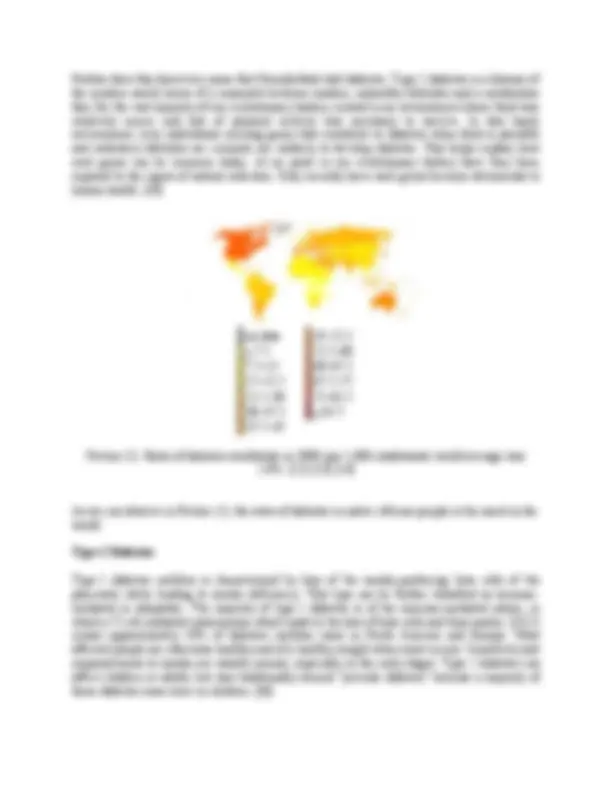
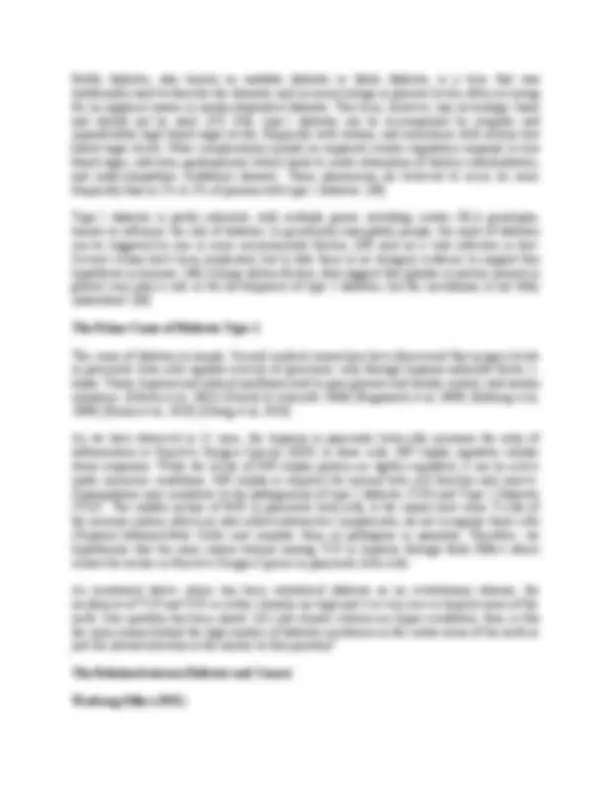
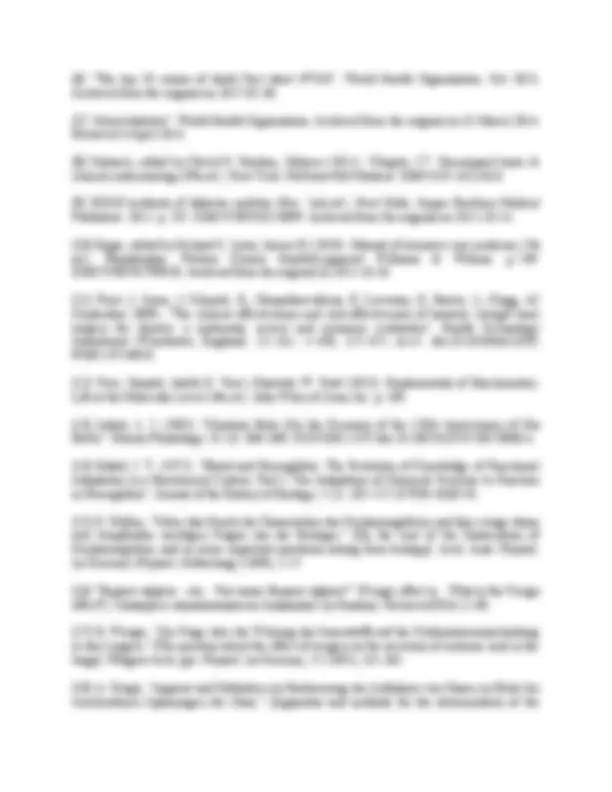
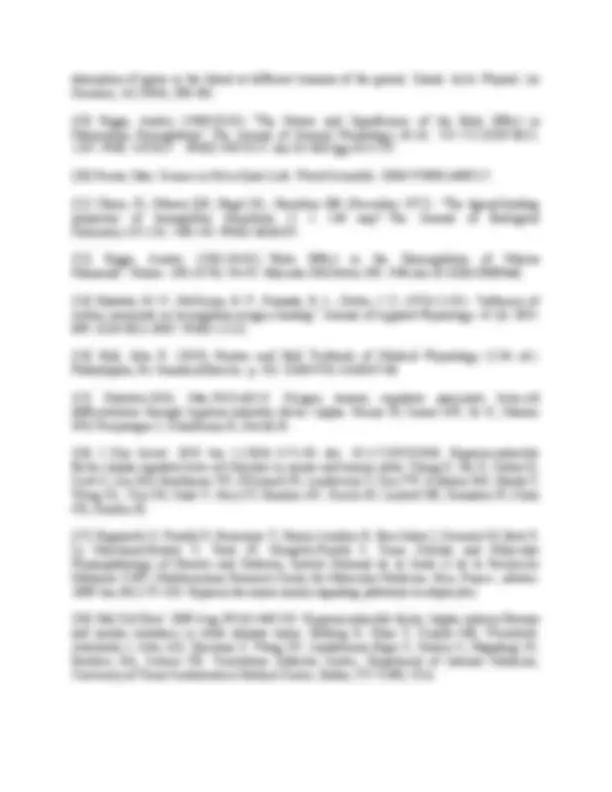
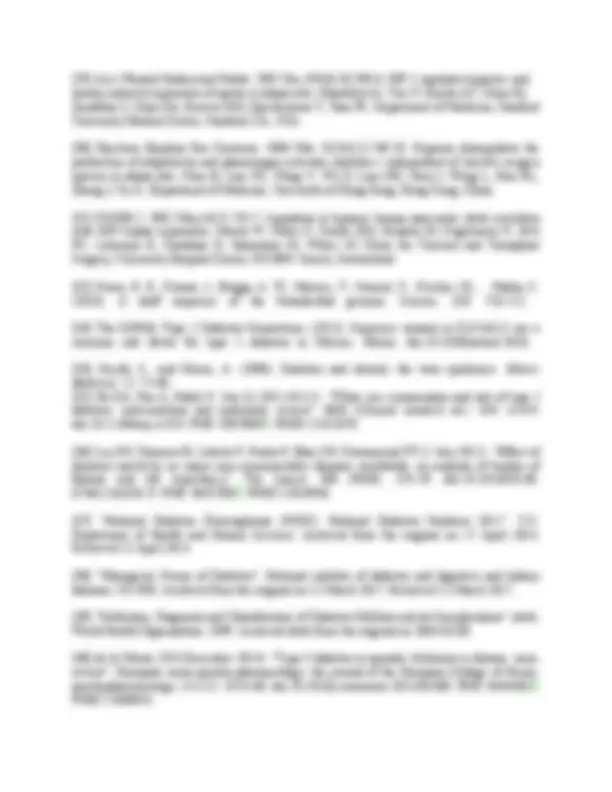


Study with the several resources on Docsity

Earn points by helping other students or get them with a premium plan


Prepare for your exams
Study with the several resources on Docsity

Earn points to download
Earn points by helping other students or get them with a premium plan
Community
Ask the community for help and clear up your study doubts
Discover the best universities in your country according to Docsity users
Free resources
Download our free guides on studying techniques, anxiety management strategies, and thesis advice from Docsity tutors
The link between chronic hypoxia in tissues and pancreatic beta-cells through the Bohr Effect, and its role in the pathogenesis of Type 1 and Type 2 Diabetes. HIF-1alpha, a transcription factor involved in cellular stress responses, is suggested to be dysregulated and contribute to the disease. Apelin, a peptide upregulated by insulin in adipocytes, is also shown to be influenced by HIF-1alpha.
What you will learn
Typology: Lecture notes
1 / 16

This page cannot be seen from the preview
Don't miss anything!










Professor Dr. Sorush Niknamian PhD in Cell and Molecular Biology, Military Medicine (Liberty University) and Board Member of Weston A Price Foundation in Washington DC, USA
Diabetes mellitus (DM) is a group of metabolic disorders in which there are high blood sugar levels over a prolonged period. Between 1985 and 2002, the number of people with diabetes grew from 30 million to 217 million, and this incidence will be expected to exceed 366 million by
2030. Type 1 diabetes mellitus is characterized by loss of the insulin-producing beta cells of the pancreatic islets, leading to insulin deficiency. This type can be further classified as immune- mediated or idiopathic. This research has gone through several important reviews plus one research on 21 mice which is done in Violet Cancer Institute (VCI) to find the prime reason behind T1D and T2D. We have reviewed the physiological and evolutionary mechanisms in both types of diabetes. In all cases, Hypoxia through Bohr Effect have been observed. The Bohr effect increases the efficiency of oxygen transportation through the blood. After hemoglobin binds to oxygen in the lungs because of the high oxygen concentrations, the Bohr effect facilitates its release in the tissues, specifically those tissues which need the most oxygen. Chronic hypoxia in tissues and pancreatic beta-cells through the Bohr Effect (BE) has been discussed in this review/ research as the reason for causing T2D and T1D. HIF-1alpha regulates cellular stress responses, While the levels of HIF-1alpha protein are tightly regulated, it can be active under normoxic conditions, Dysregulation may contribute to the pathogenesis of T2D and sudden hypoxia in pancreatic beta-cells through BE which is is the prime cause of T1D which can be of good help for researchers to focus on this physiological effect for the treatment and prevention of these two diseases. Additionally, we have discussed the main relation between diabetes and cancer in this research as well.
Diabetes Mellitus (DM) Diabetes mellitus (DM) is a group of metabolic disorders in which there are high blood sugar levels over a prolonged period. [1] Symptoms of high blood sugar include frequent urination, increased thirst, and increased hunger. [2] If left untreated, diabetes can cause many complications. Acute complications can include diabetic ketoacidosis, hyperosmolar hyperglycemic state, or death. [3] Serious long-term complications include cardiovascular disease, stroke, chronic kidney disease, foot ulcers, and damage to the eyes. [4] Diabetes is due to either the pancreas not producing enough insulin or the cells of the body not responding properly to the insulin produced. [5] There are three main types of diabetes mellitus: Type 1 DM results from the pancreas's failure to produce enough insulin. [2] This form was previously referred to as "insulin-dependent diabetes mellitus" (IDDM) or "juvenile diabetes". The cause is unknown. [5], Type 2 DM begins with insulin resistance, a condition in which cells fail to respond to insulin properly. [6] As the disease progresses a lack of insulin may also develop. [7] This form was previously referred to as "non-insulin-dependent diabetes mellitus" (NIDDM) or "adult-onset diabetes". The most common cause is excessive body weight and not enough exercise. [2], Gestational diabetes which is the third main form and occurs when pregnant women without a previous history of diabetes develop high blood sugar levels. [8] T1D must be managed with insulin injections. [3][2] T2D may be treated with medications with or without insulin. [6] Insulin and some oral medications can cause low blood sugar. [10] Weight loss surgery in those with obesity is sometimes an effective measure in those with type 2 DM. Gestational diabetes usually resolves after the birth of the baby. [11] As of 2015, an estimated 415 million people had diabetes worldwide, [5] with type 2 DM making up about 90% of the cases. [11] This represents 8.3% of the adult population, [10] with equal rates in both women and men. [9] As of 2014, trends suggested the rate would continue to rise. [7][8] Diabetes at least doubles a person's risk of early death. [2] From 2012 to 2015, approximately 1.5 to 5.0 million deaths each year resulted from diabetes. [5][6] The global economic cost of diabetes in 2014 was estimated to be US$612 billion. [1][2][3] In the United States, diabetes cost $245 billion in 2012. [10] [11] [12] Bohr Effect The Bohr Effect is a physiological phenomenon first described in 1904 by the Danish physiologist Christian Bohr, stating that hemoglobin's oxygen binding affinity is inversely related both to acidity and to the concentration of carbon dioxide.[12] Since carbon dioxide reacts with water to form carbonic acid, an increase in CO 2 results in a decrease in blood pH, [13] resulting in hemoglobin proteins releasing their load of oxygen. Conversely, a decrease in carbon dioxide provokes an increase in pH, which results in hemoglobin picking up more oxygen. [14] The Bohr effect increases the efficiency of oxygen transportation through the blood. [15] After hemoglobin binds to oxygen in the lungs due to the high oxygen concentrations, the Bohr effect facilitates its release in the tissues, particularly those tissues in most need of oxygen. When a tissue's metabolic rate increases, so does its carbon dioxide waste production. [16] When released into the bloodstream, carbon dioxide forms bicarbonate and protons through the following reaction: Although this reaction usually proceeds very slowly, the
Study done in 2010 by Heinis and Simon, when cultured in collagen, embryonic pancreatic cells were hypoxic and expressed HIF1alpha and rare beta-cells differentiated. In pancreata cultured on filter (normoxia), HIF1alpha expression decreased and numerous beta-cells developed. During pancreas development, HIF1alpha levels were elevated at early stages and decreased with time. To determine the effect of pO2 on beta-cell differentiation, pancreata were cultured in collagen at increasing concentrations of O2. Such conditions repressed HIF1alpha expression, fostered development of Ngn3-positive endocrine progenitors, and induced beta-cell differentiation by O2 in a dose-dependent manner. By contrast, forced expression of HIF1alpha in normoxia using DMOG repressed Ngn3 expression and blocked beta-cell development. Finally, hypoxia requires hairy and enhancer of split (HES)1 expression to repress beta-cell differentiation. These data demonstrate that beta-cell differentiation is controlled by pO2 through HIF1alpha. Modifying pO2 should now be tested in protocols aiming to differentiate beta-cells from embryonic stem cells. [25] One study by Cheng et al in 2010 demonstrated that Hypoxia-inducible factor-1alpha (HIF- 1alpha) is a transcription factor that regulates cellular stress responses. While the levels of HIF- 1alpha protein are tightly regulated, recent studies suggest that it can be active under normoxic conditions. We hypothesized that HIF-1alpha is required for normal beta cell function and reserve and that dysregulation may contribute to the pathogenesis of type 2 diabetes (T2D). Increasing HIF-1alpha levels markedly increased expression of ARNT and other genes in human T2D islets and improved their function. [26] Regazzetti et al in 2009 showed that in both human and murine adipocytes, hypoxia inhibits insulin signaling as revealed by a decrease in the phosphorylation of insulin receptor. In 3T3-L1 adipocytes, this inhibition of insulin receptor phosphorylation is followed by a decrease in the phosphorylation state of protein kinase B and AS160, as well as an inhibition of glucose transport in response to insulin. These processes were reversible under normoxic conditions. The mechanism of inhibition seems independent of protein tyrosine phosphatase activities. Overexpression of HIF-1alpha or -2alpha or activation of HIF transcription factor with CoCl(2) mimicked the effect of hypoxia on insulin signaling, whereas downregulation of HIF-1alpha and -2alpha by small interfering RNA inhibited it. We have demonstrated that hypoxia creates a state of insulin resistance in adipocytes that is dependent upon HIF transcription factor expression. Hypoxia could be envisioned as a new mechanism that participates in insulin resistance in adipose tissue of obese patients. [27] Halberg et al in 2009 demostrated that Adipose tissue can undergo rapid expansion during times of excess caloric intake. Like a rapidly expanding tumor mass, obese adipose tissue becomes hypoxic due to the inability of the vasculature to keep pace with tissue growth. Consequently, during the early stages of obesity, hypoxic conditions cause an increase in the level of hypoxia-inducible factor 1alpha (HIF1alpha) expression. Using a transgenic model of overexpression of a constitutively active form of HIF1alpha, we determined that HIF1alpha fails to induce the expected proangiogenic response. In contrast, we observed that HIF1alpha initiates adipose tissue fibrosis, with an associated increase in local inflammation. "Trichrome- and picrosirius red-positive streaks," enriched in fibrillar collagens, are a hallmark of adipose tissue suffering from the early stages of hypoxia-induced fibrosis. Lysyl oxidase (LOX) is a transcriptional target of HIF1alpha and acts by cross-linking collagen I and III to form the fibrillar collagen fibers. Inhibition of LOX activity by beta-aminoproprionitrile treatment results in a significant improvement in several metabolic parameters and further reduces local adipose tissue inflammation. Collectively,
our observations are consistent with a model in which adipose tissue hypoxia serves as an early upstream initiator for adipose tissue dysfunction by inducing a local state of fibrosis. [28] Glaasford et al in 2007 showed that Apelin, a novel peptide with significant cardioactive properties, is upregulated by insulin in adipocytes. However, the mechanism by which insulin promotes apelin production is unknown. Hypoxia-inducible factor-1 (HIF-1), a heterodimeric transcription factor involved in the angiogenic and metabolic responses to tissue hypoxia, has been shown to be activated by insulin in various settings. We therefore hypothesized that HIF- regulates insulin-mediated apelin expression in adipocytes. 3T3-L1 cells were differentiated into adipocytes in culture. For experiments, serum-starved 3T3-L1 cells were exposed to insulin and/ or a 1% O (2) environment. Apelin expression was assessed using quantitative real-time PCR and ELISA. To directly assess the role of HIF-1 in apelin production, we differentiated mouse embryonic fibroblasts (MEFs) containing a targeted deletion of the HIF-1alpha gene into adipocytes and measured their response to insulin and hypoxia. Apelin expression in mature 3T3-L1 adipocytes was increased significantly by insulin and was attenuated by pharmacological inhibition of insulin signaling. Exposure of cells to either hypoxia or the chemical HIF activators cobalt chloride (CoCl(2)) and dimethyloxaloylglycine (DMOG) resulted in significant upregulation of apelin, consistent with a role for HIF in apelin induction. Moreover, hypoxia-, CoCl(2)-, DMOG-, and insulin-induced apelin expression were all attenuated in differentiated HIF-1alpha-deficient MEFs. In summary, in cultured 3T3-L1 adipocytes and differentiated MEFs, HIF-1 appears to be involved in hypoxia- and insulin-induced apelin expression. [29] Chen et al in 2006 demostrated that Low plasma levels of adiponectin (hypoadiponectinemia) and elevated circulating concentrations of plasminogen activator inhibitor (PAI)-1 are causally associated with obesity-related insulin resistance and cardiovascular disease. However, the mechanism that mediates the aberrant production of these two adipokines in obesity remains poorly understood. In this study, we investigated the effects of hypoxia and reactive oxygen species (ROS) on production of adiponectin and PAI-1 in 3T3-L1 adipocytes. Quantitative PCR and immunoassays showed that ambient hypoxia markedly suppressed adiponectin mRNA expression and its protein secretion, and increased PAI-1 production in mature adipocytes. Dimethyloxallyl glycine, a stabilizer of hypoxia-inducible factor 1alpha (HIF-1alpha), mimicked the hypoxia-mediated modulations of these two adipokines. Hypoxia caused a modest elevation of ROS in adipocytes. However, ablation of intracellular ROS by antioxidants failed to alleviate hypoxia-induced aberrant production of adiponectin and PAI-1. On the other hand, the antioxidants could reverse hydrogen peroxide (H2O2)-induced dysregulation of adiponectin and PAI-1 production. H2O2 treatment decreased the expression levels of peroxisome proliferator- activated receptor gamma (PPARgamma) and CCAAT/enhancer binding protein (C/EBPalpha), but had no effect on HIF-1alpha, whereas hypoxia stabilized HIF-1alpha and decreased expression of C/EBPalpha, but not PPARgamma. Taken together, these data suggest that hypoxia and ROS decrease adiponectin production and augment PAI-1 expression in adipocytes via distinct signaling pathways. These effects may contribute to hypoadiponectinemia and elevated PAI-1 levels in obesity, type 2 diabetes, and cardiovascular diseases. [30] Moritz and Meier et al in 2002 showed that to become insulin independent, patients with type 1 diabetes mellitus require transplantation of at least two donor pancreata because of massive beta-cell loss in the early post-transplantation period. Many studies describing the introduction of new immunosuppressive protocols have shown that this loss is due to not only immunological events but also non-immunological factors. To test to what extent hypoxia may contribute to early graft
The Evolutionary roots of Diabetes The modern diabetes epidemic is caused, not by a virulent pathogen, but by the spread of an even stealthier invader which is the Western Lifestyle. As people around the world have begun to eat less healthily, lead more sedentary lives, and live to older ages, adult onset diabetes (type 2 diabetes) has become common in places where the disease was previously unknown. Between 1985 and 2002, the number of people with diabetes grew from 30 million to 217 million, and this figure is expected to exceed 366 million by 2030. But the epidemic has not been even-handed. Even accounting for differences in lifestyle, some populations have been hit particularly hard. Mexicans and Latin Americans, for example, have nearly twice the chance of developing diabetes that non-Hispanic white Americans do. New research addresses these disparities. Last month, scientists announced that they'd discovered a gene that helps explain the difference in diabetes risk among many populations. In a strange twist, the gene version in question traces its ancestry back to Neanderthals. The gene in question encodes a protein that helps move certain lipids into liver cells. The diabetes-contributing version of this gene differs from the standard gene version by five mutations—and these seem to alter the function of the protein enough to increase diabetes risk. Carriers of the mutated version of the gene are more likely to get diabetes at a younger age and with a lower degree of obesity than non-carriers. Anyone can carry this gene, but the new research found that it is more common in some populations than others. Among people with many Native American ancestors, the likelihood of carrying at least one copy of the mutated gene is greater than 50%. Among East Asians, the frequency is about 10%. Among people with mainly European ancestors, the gene version is extremely rare, and it seems to be not present at all in Africans. Because people from Mexico and Latin America are much more likely to have Native American ancestry, they are also much more likely to carry this gene version, and hence, have higher odds of developing diabetes. So diabetes risk in modern populations is tied to that population's evolutionary history. Recent research has uncovered hundreds of gene versions contributing to diseases that range from asthma to Alzheimer's disease. The surprise in this research lies in the provenance of the disease-contributing gene. Something about the new gene version struck the researchers as surprising: it had evolved too much. In big, slow-to-reproduce organisms like humans, mutations take a while to accumulate and evolution proceeds fairly slowly. Based on human DNA's usual rates of evolution, this diabetes gene version must have started diverging from the standard version almost 800,000 years ago. That's before our modern human anatomy had evolved and long before we had left Africa. Now, there's nothing surprising about a really old gene—but if this gene version first evolved in Africa in the ancestral lineage of all humans, then why don't all human populations, in particular Africans, carry it? The researchers hypothesized that perhaps the diabetes-contributing linked gene version didn't actually evolve in our direct ancestral lineage, but in Neanderthals, as shown in the diagram below. In this scenario, the gene version would have acquired many of its mutations in the Neanderthal lineage sometime after the human and Neanderthal lineages split from one another. When modern humans eventually left Africa between 60,000 and 80,000 years ago and arrived in
Europe and the Middle East, Neanderthals were already living there. Those humans and Neanderthals interbred, introducing some Neanderthal DNA (including the diabetes-linked gene version) into the human lineage—but not into all humans. Human lineages that had remained in sub-Saharan Africa never encountered Neanderthals and so did not wind up carrying any Neanderthal DNA. This scenario would help explain how the diabetes-contributing gene could be so old and not be found in Africans. [32] Picture (1) Through recent advances in recovering DNA from ancient bones, the genomes of several Neanderthal individuals have been reconstructed. The researchers searched through the DNA sequences of these samples and found what they were looking for. One of the Neanderthals (a newer fossil discovery from Denisova Cave) carried the diabetes-linked sequence. It seems that this gene version, now common among people of Native American ancestry, is a relic from the period of our history when humans walked the earth alongside other hominids. This discovery does not mean that people of Native American descent (or for that matter anyone who carries the diabetes gene version) are particularly closely related to Neanderthals. Human populations from all over the world seem to have similar degrees of Neanderthal ancestry between 1 and 4%. we all just carry different subsets of Neanderthal-derived genes—that is, unless your ancestors are from sub-Saharan Africa, where many people have no Neanderthal ancestry at all. [33]
Brittle diabetes, also known as unstable diabetes or labile diabetes, is a term that was traditionally used to describe the dramatic and recurrent swings in glucose levels, often occurring for no apparent reason in insulin-dependent diabetes. This term, however, has no biologic basis and should not be used. [37] Still, type 1 diabetes can be accompanied by irregular and unpredictable high blood sugar levels, frequently with ketosis, and sometimes with serious low blood sugar levels. Other complications include an impaired counter-regulatory response to low blood sugar, infection, gastroparesis (which leads to erratic absorption of dietary carbohydrates), and endocrinopathies (Addison's disease). These phenomena are believed to occur no more frequently than in 1% to 2% of persons with type 1 diabetes. [38] Type 1 diabetes is partly inherited, with multiple genes, including certain HLA genotypes, known to influence the risk of diabetes. In genetically susceptible people, the onset of diabetes can be triggered by one or more environmental factors, [39] such as a viral infection or diet. Several viruses have been implicated, but to date there is no stringent evidence to support this hypothesis in humans. [40] Among dietary factors, data suggest that gliadin (a protein present in gluten) may play a role in the development of type 1 diabetes, but the mechanism is not fully understood. [36] The Prime Cause of Diabetes Type- The cause of diabetes is simple. Several medical researchers have discovered that oxygen levels in pancreatic beta-cells regulate activity of pancreatic cells through hypoxia-inducible factor 1- alpha. Tissue hypoxia and reduced perfusion lead to poor glucose and insulin control, and insulin resistance. [Moritz et al, 2002] [Carroll & Ashcroft, 2006] [Regazzetti et al, 2009] [Halberg et al, 2009] [Heinis et al, 2010] [Cheng et al, 2010] As we have observed in 21 mice, the hypoxia in pancreatic beta-cells increases the rates of inflammation or Reactive Oxygen Species (ROS) in these cells. HIF-1alpha regulates cellular stress responses. While the levels of HIF-1alpha protein are tightly regulated, it can be active under normoxic conditions. HIF-1alpha is required for normal beta cell function and reserve. Dysregulation may contribute to the pathogenesis of type 2 diabetes (T2D) and Type 1 Diabetes (T1D). The sudden incline of ROS in pancreatic beta-cells, is the reason how come T-cells of the immune system which are also called autoreactive lymphocytes, do not recognize these cells (Hypoxic-Inflamed-Beta Cells) and consider them as pathogens or parasites. Therefore; we hypothesize that the main reason behind causing T1D is hypoxia through Bohr Effect which causes the incline in Reactive Oxygen Species in pancreatic beta-cells. As mentioned above where has been introduced diabetes as an evolutionary disease, the incidences of T1D and T2D in colder climates are high and it is very rare in tropical areas of the earth. One question has been raised: All cold climate citizens are hyper-ventilators, thus, is this the main reason behind the high number of diabetes incidences in the colder areas of the earth or just the natural selection is the answer to this question? The Relation between Diabetes and Cancer Warburg Effect (WE)
The Warburg effect is a consequence of damage to the mitochondria in cancer, or an adaptation to low-oxygen environments within tumors, or a result of cancer genes shutting down the mitochondria because they are involved in the cell's apoptosis program which would normally kill cancerous cells. It may also be an effect associated with cell proliferation. Because glycolysis provides most of the building blocks required for cell proliferation, cancer and normal proliferating cells have been proposed to need to activate glycolysis, despite the presence of oxygen, to proliferate [41]. Evidence attributes some of the high aerobic glycolytic rates to an over-expressed form of mitochondrial-bound hexokinase [42] responsible for driving the high glycolytic activity. In kidney cancer, this effect could be simply because of the presence of mutations in the von Hippel-Lindau tumor suppressor gene upregulating glycolytic enzymes, including the M2 splice isoform of pyruvate kinase [43]. As we have discussed previously in this research, the cause of T1D and T2D is the hypoxia in pancreatic beta-cells and tissues. The researches by Dr. S. Zaminpira and Dr. S. Niknamian in 2017 in Violet Cancer Institute (VCI), has mentioned cancer as an evolutionary metabolic disease which completes the Warburg Hypothesis (WH) of cancer and has shown the prime cause of cancer is increasing the amounts of ROS in normal cells which damages the mitochondria and shifts their aerobic respiration into anaerobic fermentation like the eukaryotic cells in 1.5 billion years ago in evolution. This hypothesis is called Evolutionary Metabolic Hypothesis of Cancer (EMHC). [S. Zaminpira, S. Niknamian, ECRONICON, 2017] The reason why the rates of cancer in diabetic patients are high is due to the hypoxia and increasing the amounts of ROS in tissues and pancreatic beta-cells which causes damages to the mitochondria. This is because of the Bohr Effect (BE). Increasing the amounts of hypoxia plus the present high sugar in the blood causes the normal cells become cancer cells through Warburg Effect (WE). [S. Zaminpira, S. Niknamian, LAP LAMBERT PUBLICATION GROUP, 2017] Ozone Therapy and Diabetes Mellitus (DM) One important clinical study by Oleg V. Maslennikov et al showed that the ozone therapy would be one of the best way of the treatment of diabetes mellitus. The paper considers the ozone therapy treatment for the patients with DM. the treatment mode is suggested which includes intravenous infusions of the ozonized saline, minor autohaemotherapy, subcutaneous injection of gas mixtures into triggered points, injections of gas mixture into biologically active points and flowing gassing in plastic camera. The course of the treatment is intended for three weeks the results for the 94 patients are presented. It is shown that the suggested ozone therapy mode is effective for diabetic with different forms. It is demonstrated that the ozone therapy intensifies the action of the glucose reduction medicaments. Facilitates the disease symptoms removal, decreases the hyperglycemia, eliminates hypoxia and endogenous intoxication. The given treatment results prove that the ozone therapy may be used for the non-complicated disease as well as for the complicated diabetes. The effectiveness of the ozone therapy for the treatment of these patients was 92% which is outstanding. [Oleg V. Maslennikov et al, 2005] There are some other researches on the ozone therapy for the treatment of diabetes and cancer which have been written and discussed by Dr. Somayeh Zaminpira and Dr. Sorush Niknamian
[6] "The top 10 causes of death Fact sheet N°310". World Health Organization. Oct 2013. Archived from the original on 2017-05-30. [7] "About diabetes". World Health Organization. Archived from the original on 31 March 2014. Retrieved 4 April 2014. [8] Shoback, edited by David G. Gardner, Dolores (2011). "Chapter 17". Greenspan's basic & clinical endocrinology (9th ed.). New York: McGraw-Hill Medical. ISBN 0-07-162243-8. [9] RSSDI textbook of diabetes mellitus (Rev. 2nd ed.). New Delhi: Jaypee Brothers Medical Publishers. 2012. p. 235. ISBN 9789350254899. Archived from the original on 2015-10-14. [10] Rippe, edited by Richard S. Irwin, James M. (2010). Manual of intensive care medicine (5th ed.). Philadelphia: Wolters Kluwer Health/Lippincott Williams & Wilkins. p. 549. ISBN 9780781799928. Archived from the original on 2015-10-26. [11] Picot, J; Jones, J; Colquitt, JL; Gospodarevskaya, E; Loveman, E; Baxter, L; Clegg, AJ (September 2009). "The clinical effectiveness and cost-effectiveness of bariatric (weight loss) surgery for obesity: a systematic review and economic evaluation". Health Technology Assessment (Winchester, England). 13 (41): 1–190, 215–357, iii–iv. doi:10.3310/hta13410. PMID 19726018. [12] Voet, Donald; Judith G. Voet; Charlotte W. Pratt (2013). Fundamentals of Biochemistry: Life at the Molecular Level (4th ed.). John Wiley & Sons, Inc. p. 189. [13] Irzhak, L. I. (2005). "Christian Bohr (On the Occasion of the 150th Anniversary of His Birth)". Human Physiology. 31 (3): 366–368. ISSN 0362-1197.doi:10.1007/s10747-005-0060-x. [14] Edsall, J. T. (1972). "Blood and Hemoglobin: The Evolution of Knowledge of Functional Adaptation in a Biochemical System. Part I: The Adaptation of Chemical Structure to Function in Hemoglobin". Journal of the History of Biology. 5 (2): 205–257.JSTOR 4330576. [15] G. Hüfner, "Ueber das Gesetz der Dissociation des Oxyharmoglobins und iiber einige daran sich knupfenden wichtigen Fragen aus der Biologie," [On the Law of the Dissociation of Oxyharmoglobin, and on some important questions arising from biology]. Arch. Anat. Physiol. (in German) (Physiol. Abtheilung) (1890), 1-27. [16] "Вериго эффект - это... Что такое Вериго эффект?" [Verigo effect is... What is the Verigo effect?]. Словари и энциклопедии на Академике (in Russian). Retrieved2016-11-08. [17] B. Werigo, "Zur Frage uber die Wirkung des Sauerstoffs auf die Kohlensaureausscheidung in den Lungen," [The question about the effect of oxygen on the secretion of carbonic acid in the lungs]. Pflugers Arch. ges. Physiol. (in German), 51 (1892), 321-361. [18] A. Krogh, "Apparat und Methoden zur Bestimmung der Aufnahme von Gasen im Blute bei verschiedenen Spannungen der Gase," [Apparatus and methods for the determination of the
absorption of gases in the blood at different tensions of the gases]. Skand. Arch. Physiol. (in German), 16 (1904), 390-401. [19] Riggs, Austen (1960-03-01). "The Nature and Significance of the Bohr Effect in Mammalian Hemoglobins". The Journal of General Physiology. 43 (4): 737–752.ISSN 0022-
PMC 2195025. PMID 19873527. doi:10.1085/jgp.43.4.737. [20] Perutz, Max. Science is Not a Quiet Life. World Scientific. ISBN 9789814498517. [21] Olson, JS; Gibson QH; Nagel RL; Hamilton HB (December 1972). "The ligand-binding properties of hemoglobin Hiroshima (2 2 146 asp)". The Journal of Biological Chemistry.247 (23): 7485–93. PMID 4636319. [22] Riggs, Austen (1961-04-01). "Bohr Effect in the Hæmoglobins of Marine Mammals". Nature. 190 (4770): 94–95. Bibcode:1961Natur.190...94R.doi:10.1038/190094a0. [23] Hlastala, M. P.; McKenna, H. P.; Franada, R. L.; Detter, J. C. (1976-12-01). "Influence of carbon monoxide on hemoglobin-oxygen binding". Journal of Applied Physiology. 41 (6): 893–
ISSN 0021-8987. PMID 12132. [24] Hall, John E. (2010). Guyton and Hall Textbook of Medical Physiology (12th ed.). Philadelphia, Pa: Saunders/Elsevier. p. 502. ISBN 978-1416045748. [25] Diabetes,2010, Mar;59(3):662-9. Oxygen tension regulates pancreatic beta-cell differentiation through hypoxia-inducible factor 1alpha. Heinis M, Simon MT, Ilc K, Mazure NM, Pouyssugur J, Scharfmann R, Duvilli B. [26] J Clin Invest. 2010 Jun 1;120(6):2171-83. doi: 10.1172/JCI35846. Hypoxia-inducible factor-1alpha regulates beta cell function in mouse and human islets. Cheng K, Ho K, Stokes R, Scott C, Lau SM, Hawthorne WJ, O'Connell PJ, Loudovaris T, Kay TW, Kulkarni RN, Okada T, Wang XL, Yim SH, Shah Y, Grey ST, Biankin AV, Kench JG, Laybutt DR, Gonzalez FJ, Kahn CR, Gunton JE. [27] Regazzetti C, Peraldi P, Grumeaux T, Najem-Lendom R, Ben-Sahra I, Cormont M, Bost F, Le Marchand-Brustel Y, Tanti JF, Giorgetti-Peraldi S. Team Cellular and Molecular Physiopathology of Obesity and Diabetes, Institut National de la Sante et de la Recherche Modicale U 895, Mediterranean Research Centre for Molecular Medicine, Nice, France., iabetes. 2009 Jan;58(1):95-103. Hypoxia decreases insulin signaling pathways in adipocytes. [28] Mol Cell Biol. 2009 Aug;29(16):4467-83. Hypoxia-inducible factor 1alpha induces fibrosis and insulin resistance in white adipose tissue. Halberg N, Khan T, Trujillo ME, Wernstedt- Asterholm I, Attie AD, Sherwani S, Wang ZV, Landskroner-Eiger S, Dineen S, Magalang UJ, Brekken RA, Scherer PE. Touchstone Diabetes Center, Department of Internal Medicine, University of Texas Southwestern Medical Center, Dallas, TX 75390, USA.
[41] Christofk HR, Vander Heiden MG, Harris MH, Ramanathan A, Gerszten RE, Wei R, Fleming MD, Schreiber SL, Cantley LC (March 2008). "The M2 splice isoform of pyruvate kinase is important for cancer metabolism and tumour growth". Nature. 452 (7184): 230–3. Bibcode:2008 Natur. 452..230C. doi:10.1038/ nature06734. PMID 18337823. [42] Pedersen PL (June 2007). "Warburg, me and Hexokinase 2: Multiple discoveries of key molecular events underlying one of cancers' most common phenotypes, the "Warburg Effect", i.e., elevated glycolysis in the presence of oxygen". Journal of Bioenergetics and Biomembranes. 39 (3): 211–22. doi:10.1007/s10863-007-9094-x. PMID 17879147. [43] Pelicano H, Martin DS, Xu RH, Huang P (August 2006). "Glycolysis inhibition for anticancer treatment". Oncogene. 25 (34): 4633–46. doi: 10.1038/sj.onc. 1209597. PMID